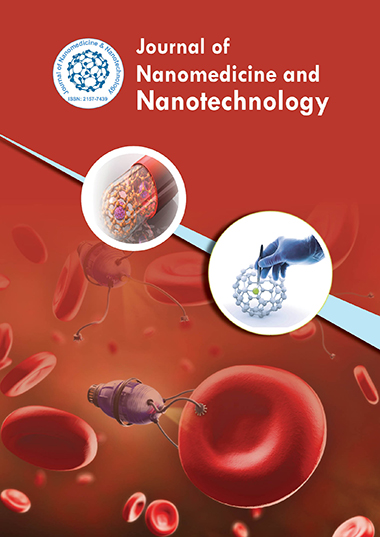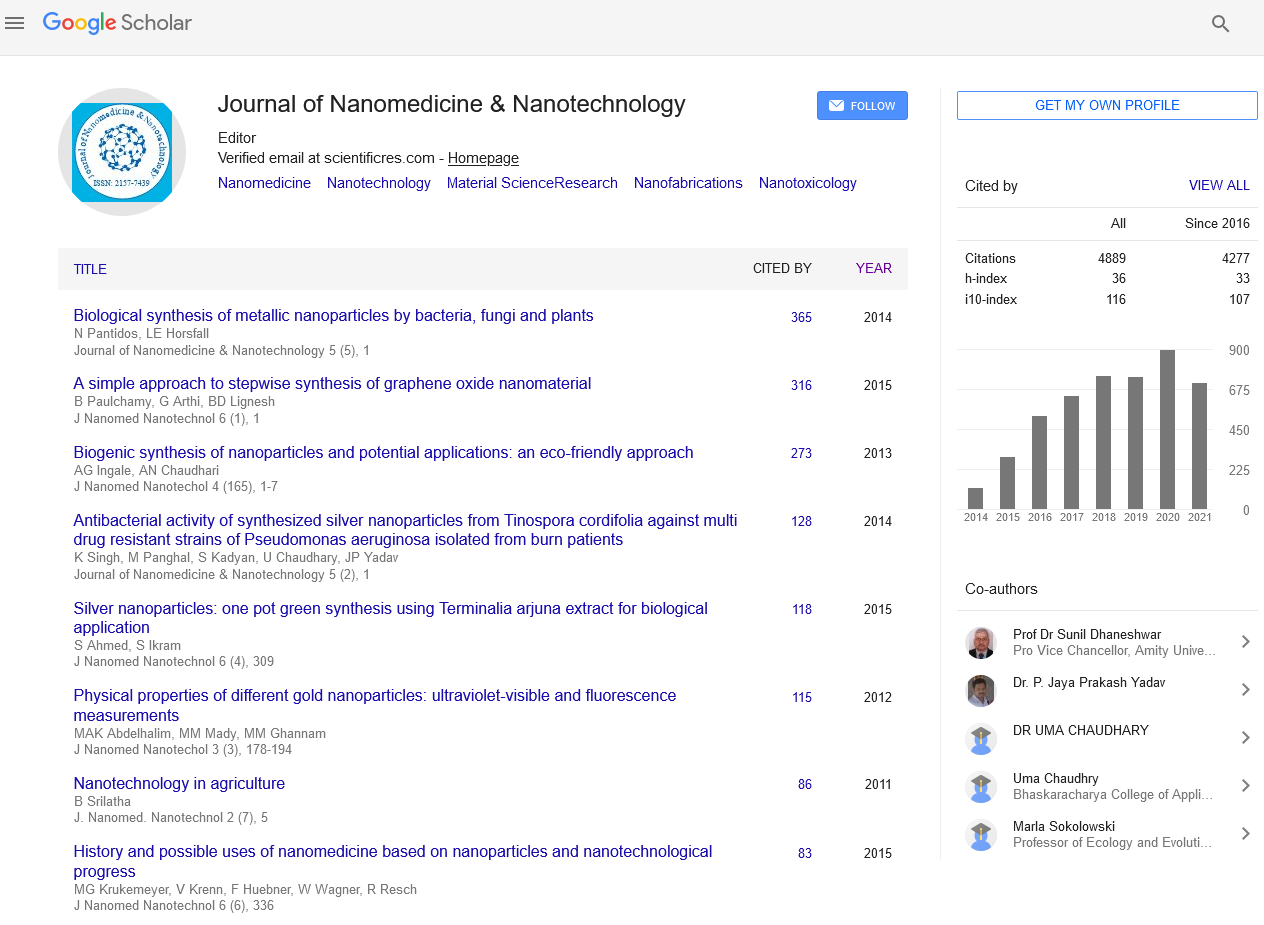Indexed In
- Open J Gate
- Genamics JournalSeek
- Academic Keys
- JournalTOCs
- ResearchBible
- China National Knowledge Infrastructure (CNKI)
- Scimago
- Ulrich's Periodicals Directory
- Electronic Journals Library
- RefSeek
- Hamdard University
- EBSCO A-Z
- OCLC- WorldCat
- SWB online catalog
- Virtual Library of Biology (vifabio)
- Publons
- MIAR
- Scientific Indexing Services (SIS)
- Euro Pub
- Google Scholar
Useful Links
Share This Page
Journal Flyer

Open Access Journals
- Agri and Aquaculture
- Biochemistry
- Bioinformatics & Systems Biology
- Business & Management
- Chemistry
- Clinical Sciences
- Engineering
- Food & Nutrition
- General Science
- Genetics & Molecular Biology
- Immunology & Microbiology
- Medical Sciences
- Neuroscience & Psychology
- Nursing & Health Care
- Pharmaceutical Sciences
Editorial - (2025) Volume 16, Issue 2
The Evolution of Material Science: From Traditional Metals to Smart Materials
Kjell Osterberg*Received: 01-Mar-2025, Manuscript No. jnmnt-25-28602; Editor assigned: 05-Mar-2025, Pre QC No. jnmnt-25-28602 (PQ); Reviewed: 20-Mar-2025, QC No. jnmnt-25-28602; Revised: 25-Mar-2025, Manuscript No. jnmnt-25-28602 (R); Published: 31-Mar-2025
Abstract
Material science has evolved significantly over the centuries, from the use of traditional metals to the development of advanced smart materials. This interdisciplinary field plays a crucial role in shaping industries such as aerospace, medicine, electronics, and construction. The transition from classical materials like metals and ceramics to nanomaterials, biomaterials, and responsive smart materials has opened new possibilities for innovation. With the emergence of materials that can self-heal, change properties in response to external stimuli, and improve sustainability, material science continues to revolutionize technology. This article explores the historical evolution of materials, recent advancements, challenges, and future prospects in the field.
Keywords
Material science; Traditional metals; Smart materials; Nanotechnology; Biomaterials; Self-healing materials; Advanced composites; Sustainable materials; Innovation in materials; Structural engineering
INTRODUCTION
Material science is a multidisciplinary field that studies the properties, structure, and applications of different materials to develop innovative solutions for various industries. The evolution of materials has been instrumental in shaping human civilization, from the Bronze Age and Iron Age to the modern era of high-performance polymers, composites, and smart materials. The need for stronger, lighter, and more functional materials has driven scientific discoveries and technological advancements. As materials have become more sophisticated, they have enabled the development of high-tech applications in electronics, medical devices, and space exploration. Understanding the journey from traditional metals to smart materials is essential for appreciating the profound impact of material science on society [1,2].
DESCRIPTION
The early history of material science is marked by the use of natural and elemental materials such as stone, clay, and metals. Ancient civilizations used copper, bronze, and iron to craft tools, weapons, and infrastructure. The Industrial Revolution introduced steel and aluminum, revolutionizing construction, transportation, and manufacturing. The 20th century saw the rise of polymers, ceramics, and composite materials, further expanding the range of applications [3,4].
In recent decades, material science has focused on the development of advanced and smart materials. Nanomaterials, including carbon nanotubes and graphene, have exceptional mechanical and electrical properties, making them ideal for high-performance applications. Biomaterials have transformed the medical field by enabling biocompatible implants and tissue engineering. Additionally, self-healing materials and shape-memory alloys have introduced a new level of adaptability and longevity in material applications, further pushing the boundaries of engineering and technology [5,6].
DISCUSSION
The evolution of material science has brought numerous advancements, yet challenges remain. One of the key concerns is the sustainability of material production and disposal. Traditional materials like plastics and heavy metals contribute to environmental pollution, prompting researchers to develop eco-friendly alternatives such as biodegradable polymers and recyclable composites. The integration of sustainable practices in material science is essential for reducing the ecological impact of industrial activities [7,8].
Another challenge is the high cost and scalability of advanced materials. While smart materials offer incredible functionalities, their manufacturing processes often require sophisticated technologies and rare elements, making them expensive. Researchers continue to work on cost-effective production methods and alternative material sources to overcome these limitations [9,10].
Moreover, the interdisciplinary nature of material science requires collaboration between physicists, chemists, engineers, and biologists. The development of next-generation materials relies on a deep understanding of atomic structures, molecular interactions, and macroscopic behaviors. The application of artificial intelligence and computational modeling has accelerated the discovery and optimization of new materials, allowing scientists to predict material behavior and enhance design processes efficiently.
CONCLUSION
Material science has undergone a remarkable transformation, from the use of traditional metals to the development of highly advanced smart materials. This evolution has not only improved industrial applications but has also paved the way for sustainable, self-healing, and adaptive materials that cater to modern technological needs. While challenges related to cost, environmental impact, and interdisciplinary collaboration persist, ongoing research and innovation continue to push the boundaries of what materials can achieve. As material science advances, it will play an even more significant role in shaping the future of technology, infrastructure, and sustainability.
ACKNOWLEDGEMENT
None
CONFLICT OF INTEREST
None
References
- Sharma N, Baldi A, Garg S. Cyclodextrins: encapsulation of drugs. Critical Reviews in Therapeutic Drug Carrier Systems. 2019; 19(3): 185-208.
- Narayanan N, Sudhakumari C C. Cyclodextrin as a tool in enhanced drug delivery. Polym Renew Resour. 2021;10(2): 77-84.
- Smith, K A, Buhro, W E. Synthesis of surface-stabilized beta-cyclodextrin/gold nanoparticle assemblies. Nanoscale Advances. 2020; 2(2): 527-535.
- Xia Q, Cai Y, Zheng J, Zhang J. Nanomaterials-based photothermal therapy and its potentials in antibacterial treatment. Journal of Controlled Release. 2021; 330: 75-90.
- Narayanan, K B, Sakthivel N. Green synthesis of biogenic metal and metal oxide nanoparticles and their effect on the bioactivity of pharmaceuticals. Journal of Molecular Liquids. 2020; 300: 112202.
- Li Z, Zhang Y, Fullston D, Shen Y. Advanced carbon-based nanomaterials for tumor photothermal therapy. Nanomaterials. 2021;11(5): 1137.
- Wang Y, Qi X, Lu L, Xu X. Anticancer properties of sulfated chitosan. Biol Trace Elem Res. 2019;192(2): 205-212.
- Li J, Wang X, Zhang T, Wang C, Huang Z, Luo et al . Polypyrrole/chitosan-coated Fe3O4 nanoparticles for MRI-guided photothermal cancer therapy. Biomedical Materials. 2020; 15(4): 045001.
- Brown S A, Hansbro, P M, Hansbro, N G. Animal models of asthma: value, limitations and opportunities for alternative approaches. Drug Discovery Today. 2019; 24(1): 206-218.
- Jones, J R, Barrère F, van Blitterswijk, C A. Calcium phosphate ceramics as bone graft substitutes in filling bone tumors. Pharmaceuticals. 2020; 3(3): 125.
Indexed at, Google Scholar, Crossref
Indexed at, Google Scholar, Crossref
Indexed at, Google Scholar, Crossref
Indexed at, Google Scholar, Crossref
Indexed at, Google Scholar, Crossref
Indexed at, Google Scholar, Crossref
Indexed at, Google Scholar, Crossref
Citation: Kjell O (2025) The Evolution of Material Science: From Traditional Metals to Smart Materials. J Nanomed Nanotech. 16: 778.
Copyright: ©2025 Kjell O. This is an open-access article distributed under the terms of the Creative Commons Attribution License, which permits unrestricted use, distribution, and reproduction in any medium, provided the original author and source are credited.


